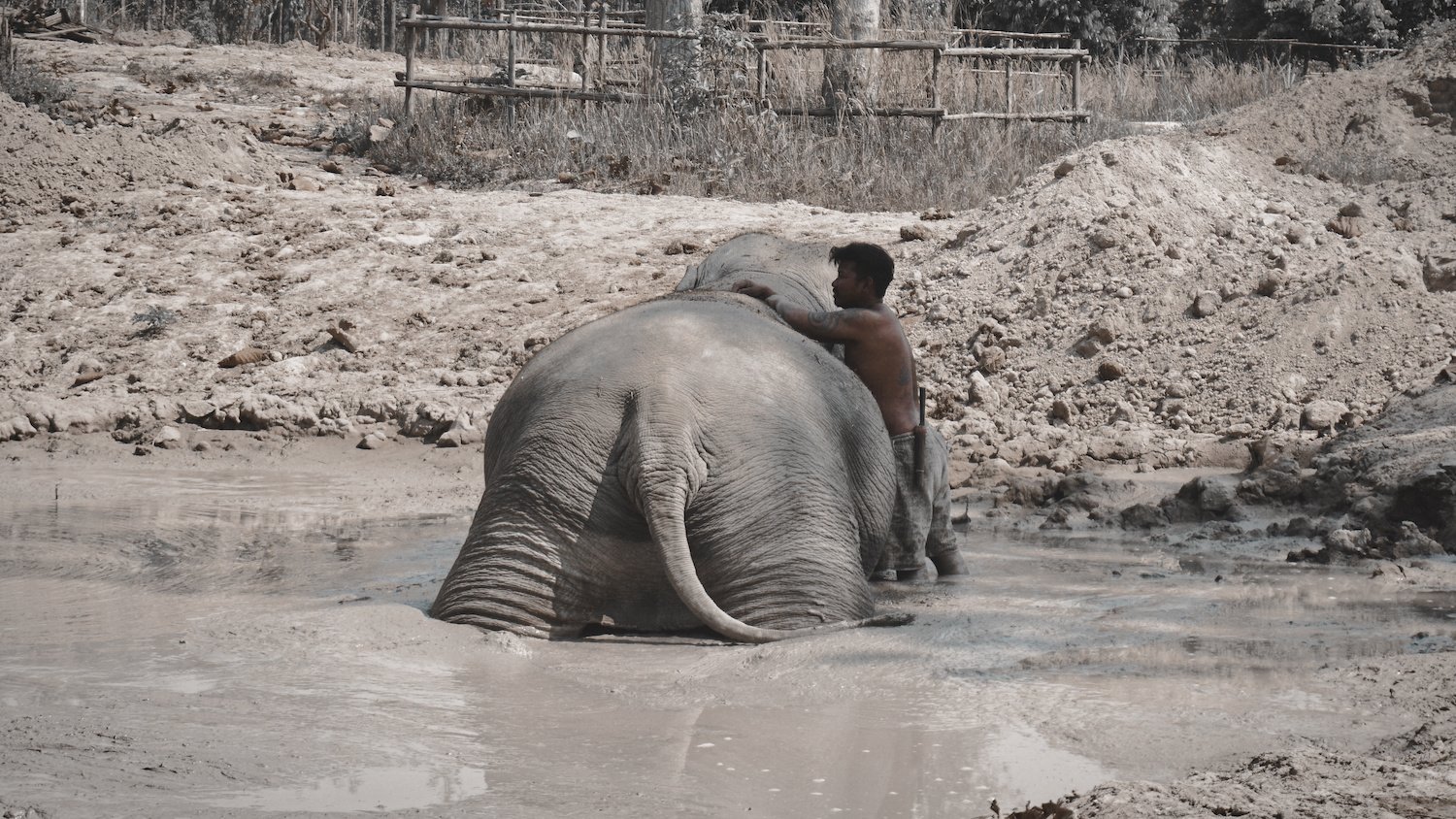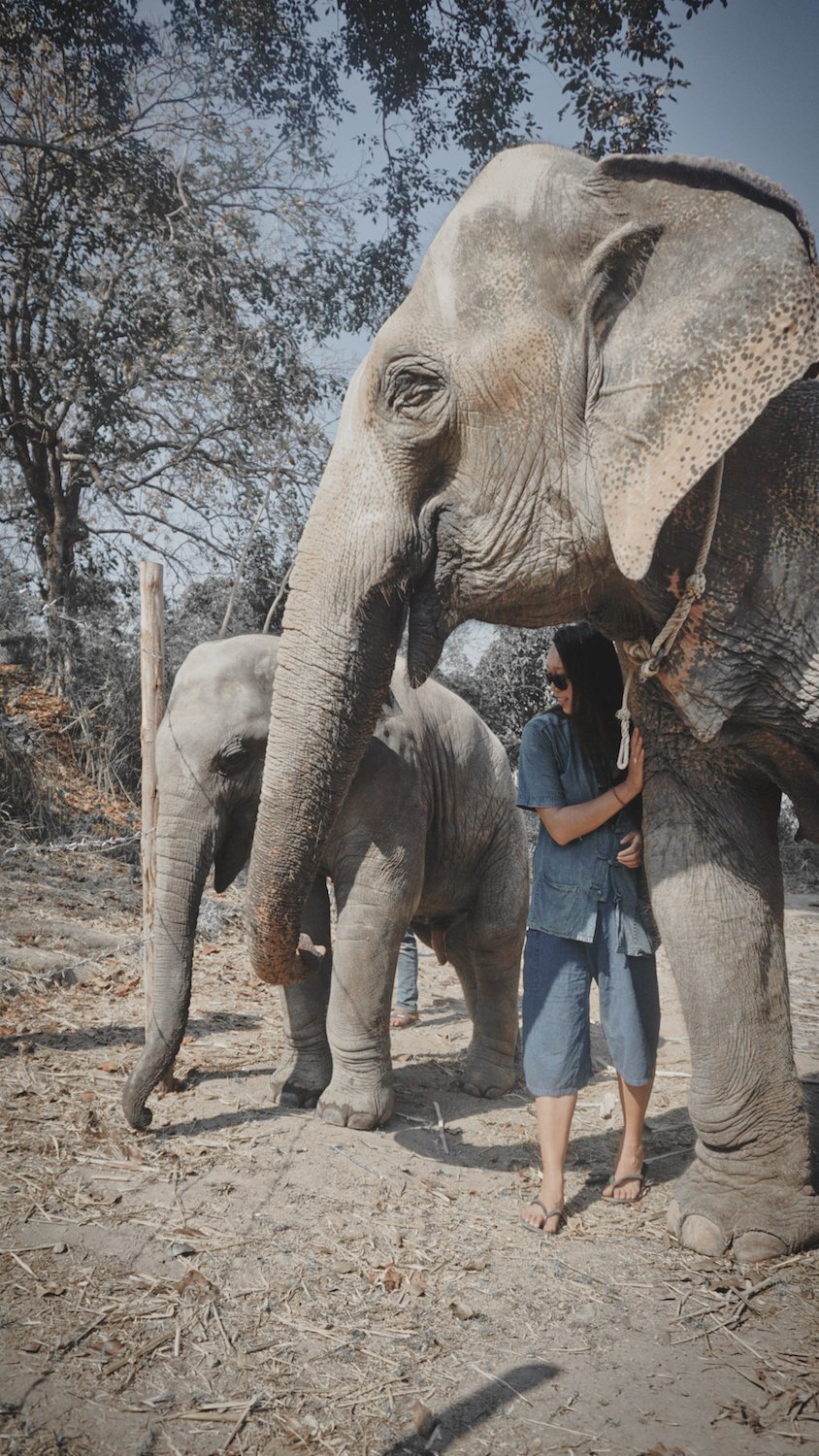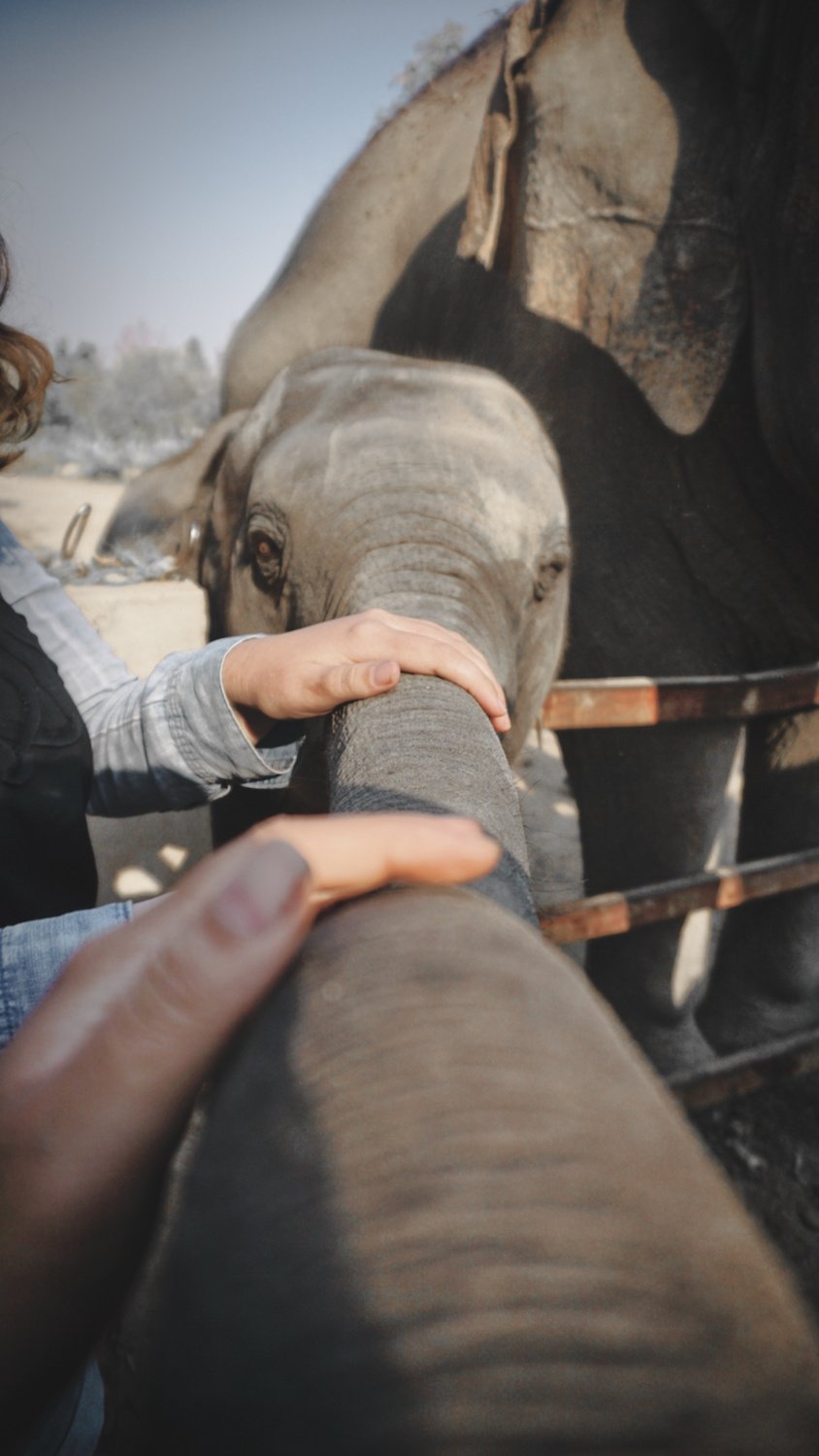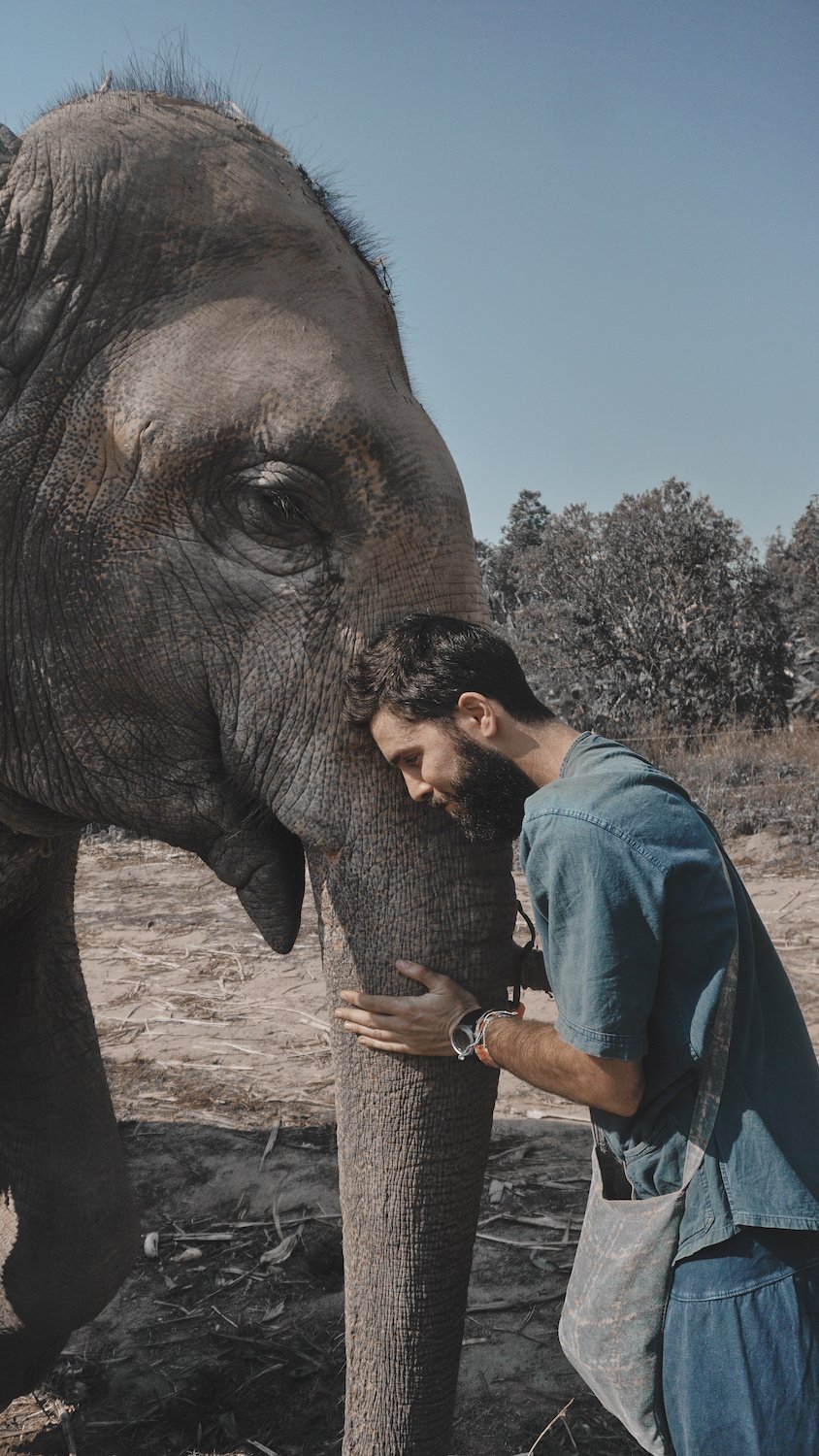Maerim Elephant Sanctuary in Chiang Mai (How to Choose Ethical Elephant Sanctuaries in Thailand)
It was not long ago, that elephant riding was still a widespread and very popular activity for tourists and locals to do. People came to Thailand to ride elephants. Nowadays, thanks to the internet and social media exposure, many people are becoming more mindful of animal welfare and choosing to support the more ethical local providers instead.
This article will explain what to look out for when choosing an ethical provider, what a typical day at an elephant sanctuary looks like, how much it costs, where to find and book a tour, and lastly, a more personal story with some varying opinions and experiences from people I talked to.
CONTENT:
Why is it Important to Choose Ethical Providers?
How to choose an Ethical Elephant Sanctuary?
My Experience at the Maerim Elephant Sanctuary
Where to Find and Book a Visit?
My Personal Story and Thoughts
1. Why is it Important to Choose Ethical Providers?
We have so much power in the way we choose to spend our money. By supporting ethical causes, we put pressure on the remaining elephant riding camps to change their ways.
This is the power, we as consumers have. Collectively, our educated decision making has led to hundreds of elephants being freed from riding camps. Many new elephant sanctuaries are opening up too because it’s become more profitable to do so. People would rather pay and see happy elephants than to ride and assert their dominance over a broken animal.
The money you spend on these ethical elephant sanctuaries normally gets funnelled back into saving another elephant from a life of misery either in the circus industry, logging industry or riding camps.
2. How to choose an Ethical Elephant Sanctuary?
There is a huge variety amongst the ‘ethical’ elephant sanctuary providers. Some let you wash the elephants but do not encourage mud baths with them, while others do. Some have much larger roaming areas for the elephants, while others are confined to a smaller area for their own safety. Some only provide bananas for you to feed the elephants, while others teach you how to cook a variety of food for them such as rice with vegetables.
Tips for ethical elephant Sanctuaries:
Make sure they don’t offer riding in any of their tours
Stay away from providers who offer bizarre, unnatural things such as watch elephants paint or play soccer
Enquire how many people they normally have per tour
Read past reviews on Google or Trip Advisor
Tip 1: Make sure they don’t offer riding in any of their tours
When in Thailand, you are bombarded with dozens and dozens of elephant providers - many who may claim to be ‘elephant friendly’ because they offer a no-riding option, then you keep reading and this is often what you see:
Option A: Elephant Friendly Tour - No Riding
Option B: Elephant Bare Back Riding
The companies who do offer elephant riding are comparatively much cheaper than the ethical ones. They do this to entice more customers because demand and business for elephant riding is dwindling.
But apparently there still exists a good portion of people who care more about saving a few dollars than the welfare of these animals.
Yes, of course you can do the ‘no riding’ option and excuse yourself from harming elephants, but you are still directly supporting a business that endorses the cruel enslavement of elephants for human entertainment. Your money would go towards the perpetuation of the elephants’ suffering.
It’s not easy to sift through so many companies and trying to choose the most ethical one. I urge you to always enquire about the history of the company. Ask if they offer riding and if they used to offer riding.
Many simply cut out the riding part because it was giving them a bad name and making them unprofitable as a business. Therefore, you get a lot of providers who don’t necessarily care about the welfare of the elephants and perhaps still treat cruelly behind the scenes.
Tip 2: Stay away from providers who offer bizarre, unnatural things such as watch elephants paint or play soccer
It goes without saying that it’s very unnatural and the elephants are forced through starvation and pointy metal sticks being jabbed into their faces for this ‘spectacle’ to happen so that they can be further laughed at and ridiculed by us humans.
Tip 3: Enquire how many people they normally have per tour
Some have more than 30 people per tour while others only 10-15. It’s not only that you will personally enjoy the tour more if there are fewer people, but I think the elephants themselves would prefer tours where they are bombarded with fewer humans. It also creates a more relaxed and more engaged group of people, in my opinion.
Tip 4: Read past reviews on Google or Trip Advisor
Reading reviews really helps to get a feel for the tour provider, such as: how large the groups will be, what activities you get to do, what the elephants eat, what their environment is like, how informative the guides were, how did they treat the elephants, etc. Overall, you get a pretty good feel as to what they stand for.
But also, find the negatives. What was the reason for the negative review? Did they feel the elephants weren’t being treated ethically? Were there too many people on the tour? The negatives are just as important as the positives.
4. My Experience at the Maerim Elephant Sanctuary
Maerim Elephant Sanctuary was recommended to me through word of mouth by a friend and fellow backpacker. We decided to do a morning half day tour so that we could escape being outside during the most heat intensive period of the day - and we thoroughly enjoyed ourselves.
Quick Facts about the Tour:
Type of tour: Half Day - Morning (or afternoon)
Number of people on tour: 30 people (full capacity)
Pick up: 7-7:30am
Drop off: 1:30pm
Cost: 1600 THB per person
What’s Included?
Transport from Chiang Mai: included in price. Red Taxi picks you up and fits 10 people, so it’s a rather tight squeeze.
Lunch included: Yes, you get to make your own noodle soup!! Delicious and vegetarian option available.
Clothes provided: Yes, you get changed into traditional clothes, which is provided as part of the tour
Mud Bath: Yes, for humans and elephants!
Elephant Swimming Pool: Yes, you get into a murky large pool to wash off all the mud
Human Swimming Pool: Yes, they have a clean filtered pool just for humans
Showers and Toilets: Yes and Yes
What do you need to bring?
Towels and Swimming Suits: Not Provided so bring your own if you want to go swimming!
Photographer on Location
They have a photographer dedicated to taking candid photos of you and the group of people you are travelling with. You have the option of purchasing these digital files at the end (but you don’t have to, of course).
In my opinion, they took very good photos and yes we did buy them, as the proceeds also go towards the cause of saving their next elephant.
What Activities are on the Half-Day Tour?
Changing into traditional clothes, then loading pockets and bags with bananas
Feeding bananas to the elephants while walking with them
Hopping into the mud pool and giving the elephants a nice mud bath
Washing off the mud in the large elephant pond
Taking a shower and hopping into the human pool
Lunch time cooking class - making your own noodle soup!
What were the Guides like?
We had two main guides who spoke great English, they were young and very enthusiastic and very informative. I also felt that they really cared about the well-being of the elephants. The video we watched at the start was partly filmed by one of the guides himself.
What were the Elephants like?
There were five elephants. Mother and Baby Boy - saved from the circus. Two other females were saved from riding camps. The most recent female was saved from seven years of slavery at a logging camp near Burma/Myanmar where she was starved and worked to the point of exhaustion.
They all bear scars from their past but they are very good with human company and they do like to engage with you. Some like to pick bananas straight from your pockets. They are beautiful creatures who are to be respected and you feel truly humbled to even be in their presence.
You can read more about the different tours they offer here: Maerim Elephant Sanctuary
What I liked most:
that they offered pick up and drop off, so transportation was not a stress; they come right to your door of whichever hostel or hotel you are staying at
we were given traditional clothes so our normal clothes stayed clean
the guides were fantastic, I really liked their positive energy
being up-close and interactive with the elephants was very humbling and it allowed for a deeper respect and bond to be formed; I think a lot of people walked away with much more appreciation for these animals and a more mindful perspective of our human impacts on their lives
the mud bath and pond were super fun for everyone; definitely not something you do everyday, so it was a really unique and fun experience; the elephants seemed to love having multiple personal masseuses
the noodle soup cooking experience was definitely a highlight as well… best noodle soup ever!
What I didn’t like so much:
Personally, there were too many people on tour. At 30 humans to 5 elephants… I’d feel intimidated if I were an elephant. I think it would’ve been much more pleasant for both the visitors and the elephants, if each tour only had a max number of 15 people or less.
Overall would I recommend Maerim Elephant Sanctuary?
Yes, definitely. But I’d also suggest looking around for other ethical providers who offer tours with 15 people or less.
However, in saying that, I realise that this is a business. More people means more money in a shorter period, but it also means the sooner they can save more elephants from riding camps, logging industry or circuses.
In order to save those elephants, they must ‘buy’ them and elephants don’t come cheap. Therefore, I cannot say much against the large tour capacity - only that, if you can find an ethical provider with fewer people per tour, then go for it. They might just be harder to find.
4. Where to Find and Book a Visit?
Online
A simple google search will bring up enough to keep you busy and scrolling for while. It’s a bit of an information overload, but if you focus on the reviews (both positives and negatives), you’ll quickly be able to filter out the unethical ones.
Many of the providers have their own websites and some allow you to book online, but some might require a phone call to confirm details.
Brochures/Pamphlets:
You will find so many pamphlets at your hostel or hotel, at various tour providers and travel agencies. Have a quick read, take a photo of the info and put them back so they can be reused. You can call the providers or go to their in-store address.
In-Store:
Usually they will have a store where you can go in and make a booking there. Best to bring cash with you. I’d recommend this as the best way to book (after you’ve done your research and chosen your provider) because you can ask some last minute questions and make double sure they have your correct address.
Practical information aside, I’d now like to share a more personal story and subjective opinion on this topic, while shining some light on the varying opinions and experiences from people I’ve talked to.
5. My Personal Story and Thoughts
Before this trip, I had never seen elephants except for those imprisoned in zoos. Like most children, I loved animals, I loved being close to them and observing them. I used to love going to Aquariums and Ocean Park to watch the dolphins and seals do tricks, I thought it was amazing that humans and animals could have such a close connection.
Oblivious? Yes. Blissfully Ignorant? Sadly, so. Perhaps if I was asked as a child, whether or not I wanted to ride an elephant - I would have stupidly said yes and thought it an amazing thing to be so close to an elephant. I was unaware and uneducated.
I still feel the shame and I still feel the guilt. That once upon a time, I indirectly supported the cause of their suffering just by going to the zoo, to Ocean Park, to watch animals do unnatural tricks for sheer human entertainment. That my demand contributed to their suffering.
It makes me sick to the stomach and I am disgusted at my past self. I want to apologise and say sorry, on behalf of my species, that we are the reason you can never return ‘home’, that you might never again see your family nor your natural habitat as we continue to destroy it through deforestation and pollution.
I see the scars embedded on the elephants’ bodies and can’t help but let a few tears fall.
“I’m so sorry you had to endure all those years of torture under the cruel hands of my species. But I’m so glad you are here now and finally safe”.
Ten years ago, riding elephants in Thailand was the norm. Or so I was told, by an elder European man who had been visiting Thailand every year for the past ten years. When I challenged him about the ethics of elephant riding and told him all the horrible behind-the-scenes stories I’d seen and heard, this was his response:
“Yes but ten years ago, it was normal. Everybody did it. Now? Suddenly it’s become such a bad thing. Elephants have been used for riding and in logging industry for the longest time. Their population (from 300,000 in Thailand at the start of the 20th Century) went down (to a mere 3,000 elephants left now) mostly due to hunting for their ivory, not just due to deforestation and human activities”.
For starters, females of the Asian elephant species don’t even have tusks, only males do. Do I even need to elaborate on the deforestation issue in South East Asia? His argument was flawed in so many ways. It seemed he was trying to exonerate himself from my accusations. His pride got in the way of his morals.
This was my response to him:
“Just because everyone does something makes it a societal norm, but it doesn’t mean it’s right. Just because it’s been a long term tradition or culture, also doesn’t mean it’s right”
Think for yourself. When you see an elephant collapse from starvation and long sticks with metal sharp tips being stabbed into their foreheads… does that not crush your soul? Does that not make you question societal norm and the cruel twisted mentality of us humans?
Yes I feel guilt too, for the actions of my past. But I didn’t know back then. I didn’t have the luxury of making an educated choice. Ask me again now, and my answer would be very different. But at the same time, I don’t exonerate myself from may past actions. Instead, I let myself feel the guilt and I use that as motivation to spread the word about not supporting these unethical providers.
These are the words I never got to say to that man:
“I don’t care that you used to ride elephants. I care about what you think now that you are aware of the cruelty behind it… would you still support them? Just because you used to do it yourself?
Just because, once upon a time, everyone did it?
I want to know, how are you going to move forward with the information you have today. Does your opinion change now, because it’s seen as a bad thing by the majority?
Or because deep down, you inherently feel bad and you truly do care for the welfare of these animals?
To what extent are you going to let your pride rule your thoughts and actions in the present?
We will never make progress, if we allow ourselves to condone these practices simply because we are too proud to admit we were wrong. “
Just so you know: All photos in this article were taken on my visit and either from my own camera or from the Photographer they had on tour.
Have you ever been to an elephant sanctuary? What was your experience like and do you have any further tips for those who are looking to source ethical providers? If you have any questions or comments you’d like to add about this article, simply leave a comment below or message me @emilypeilan


























